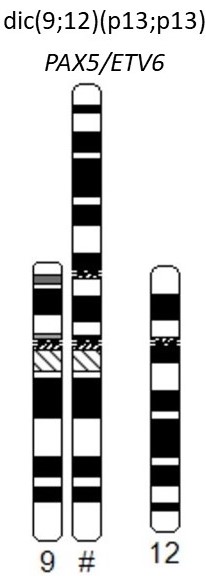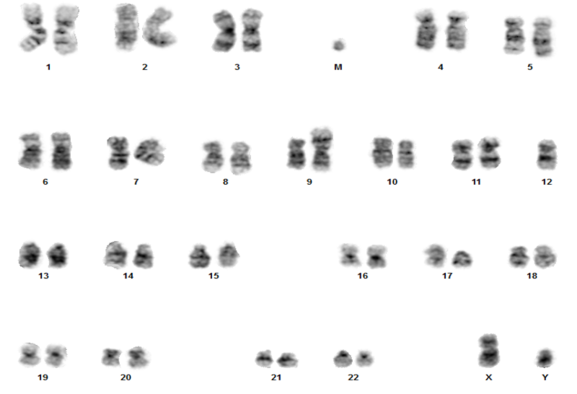B-Lymphoblastic Leukemia/Lymphoma with dic(9;12)(p13;p13); PAX5/ETV6
editPREVIOUS EDITIONThis page from the 4th edition of Haematolymphoid Tumours is being updated. See 5th edition Table of Contents.
P
| This page is under construction |
Primary Author(s)*
Celeste Eno, PhD, Cedars-Sinai Medical Center
Cancer Category/Type
B-Lymphoblastic Leukemia
Cancer Sub-Classification / Subtype
B-Lymphoblastic leukemia/lymphoma with dic(9;12)(p13;p13)
Definition / Description of Disease
B-lymphoblastic leukemia / lymphoma ( B-ALL / LBL ) with dic(9;12) is a neoplasm of lymphoblasts committed to the B-cell lineage in which the blasts harbor a translocation between PAX5 on chromosome 9 and ETV6 (formerly known as TEL) on chromosome 12.[1]
Synonyms / Terminology
PAX5/ETV6; PAX/TEL; dic(9;12)(p13;p13)
Epidemiology / Prevalence
dic(9;12) occurs predominantly in B-progenitor ALL of childhood and young adults (age range, 1-47 years, median 12 years) but not of infancy.[2] The dicentric translocation dic(9;12) is a recurrent chromosome abnormality that accounts for close to 1% of childhood acute lymphoblastic leukemia (ALL).[1]
Clinical Features
Clinical characteristics were similar to those of the general population of children with ALL.[3] One or more adverse clinical features, age > 10 years, WBC > 100 x 10(9)/l, pre-B immunophenotype, platelets < 100 x 10(9)/l, were found in over 90% of cases.[2]
| Signs and Symptoms | B-symptoms typical of children with ALL[3] (weight loss, fever, night sweats) |
| Laboratory Findings | Adverse findings in over 90%[2]:
WBC > 100 x 10(9)/l pre-B immunophenotype platelets < 100 x 10(9)/l |
Sites of Involvement
Bone marrow and peripheral blood; Patients can present with moderate organomegaly
Morphologic Features
Put your text here
Immunophenotype
The vast majority of leukemias with dic(9;12) is associated with a B-progenitor cell phenotype and belongs to the FAB L1 morphologic subtype. The blast cells express HLA-DR, CD10, CD19, CD24, and frequently also CD20 or CD22.[3]
| Finding | Marker |
|---|---|
| Positive (universal) | HLA-DR, CD10, CD19, CD24 |
| Positive (subset) | CD20 or CD22 |
| Negative (universal) | |
| Negative (subset) |
Chromosomal Rearrangements (Gene Fusions)
dic(9;12) creates the chimeric fusion between PAX5 and ETV6. The breakpoints in PAX5 are intron 4 and in ETV6 is intron 2.
| Chromosomal Rearrangement | Genes in Fusion
(5’ or 3’ Segments) |
Pathogenic Derivative | Prevalence | Diagnostic Significance (Yes, No or Unknown) | Prognostic Significance (Yes, No or Unknown) | Therapeutic Significance (Yes, No or Unknown) | Notes |
| dic(9;12)(p13;p13) | 5' PAX5 / 3' ETV6 | 1% (pediatric ALL) | Yes | No | Yes | Bone marrow transplantation is not recommended as the dic(9;12) in ALL is associated with an excellent prognosis[3]. |
Characteristic Chromosomal Aberrations / Patterns

| Chromosomal Pattern | Diagnostic Significance (Yes, No or Unknown) | Prognostic Significance
(Yes, No or Unknown) |
Therapeutic Significance
(Yes, No or Unknown) |
Notes |
| dic(9;12)[2] | Yes | Yes | No | A COG study revealed the presence of a cryptic t(12;21) fusion in patients harboring dic(9;12) [inferred ISCN: der(9;12)t(9;21)(p12;q22)t(12;21)(p13;q22)] suggesting that molecular analysis should be performed to determine whether the dicentric chromosome results in PAX5/ETV6 fusion or whether the case has ETV6/RUNX1 fusion[5]. |
| Trisomy 8[2] | Unknown | Unknown | Unknown | Trisomy 8 and additional structural chromosomal changes are recurrent.[2] |
Genomic Gain/Loss/LOH
Trisomy 8 and additional structural chromosomal changes are recurrent.[2]
Gene Mutations (SNV/INDEL)
Put your text here and/or fill in the tables
| Gene | Mutation | Oncogene/Tumor Suppressor/Other | Presumed Mechanism (LOF/GOF/Other; Driver/Passenger) | Prevalence (COSMIC/TCGA/Other) |
|---|---|---|---|---|
Other Mutations
| Type | Gene/Region/Other |
|---|---|
Epigenomics (Methylation)
Put your text here
Genes and Main Pathways Involved
PAX5 gene encodes for a transcriptional factor essential for B-cell development. The role of PAX5/ETV6 in leukemogenesis is not fully understood, although preliminary evidences suggested that the protein may have a repressor function on transcription.[6][7]
| Gene; Genetic Alteration | Pathway | Pathophysiologic Outcome |
| PAX5 | The role of PAX5/ETV6 in leukemogenesis is not fully understood, although preliminary evidences suggested that the protein may have a repressor function on transcription.[6][7] |
Diagnostic Testing Methods
- Conventional cytogenetics
- Interphase FISH
- RT-PCR for PAX5/ETV6 fusion
- Next Generation Sequencing (NGS)
Clinical Significance (Diagnosis, Prognosis and Therapeutic Implications)
This translocation is associated with an excellent prognosis.[8] A single study showed at median follow-up of 5 years, 29/31 cases (94%) remain in first remission conferring an excellent prognosis to this leukemia.[2]
Children with dic(9;12) fare extremely well, regardless of the specific type of therapy or the presence of one or more established poor risk features.
Familial Forms
Put your text here
Other Information
Put your text here
Links
References
(use "Cite" icon at top of page)
- ↑ 1.0 1.1 Strehl, S.; et al. (2003-06). "PAX5/ETV6 fusion defines cytogenetic entity dic(9;12)(p13;p13)". Leukemia. 17 (6): 1121–1123. doi:10.1038/sj.leu.2402923. ISSN 0887-6924. PMID 12764378. Check date values in:
|date=(help) - ↑ 2.0 2.1 2.2 2.3 2.4 2.5 2.6 2.7 Behrendt, H.; et al. (1995-01-XX). "Dicentric (9;12) in acute lymphocytic leukemia and other hematological malignancies: report from a dic(9;12) study group". Leukemia. 9 (1): 102–106. ISSN 0887-6924. PMID 7845002. Check date values in:
|date=(help) - ↑ 3.0 3.1 3.2 3.3 Mahmoud, H.; et al. (1992-07-XX). "The non-random dic(9;12) translocation in acute lymphoblastic leukemia is associated with B-progenitor phenotype and an excellent prognosis". Leukemia. 6 (7): 703–707. ISSN 0887-6924. PMID 1625489. Check date values in:
|date=(help) - ↑ Hiller, B.; et al. (2004-11-16). "CyDAS: a cytogenetic data analysis system". Bioinformatics. 21 (7): 1282–1283. doi:10.1093/bioinformatics/bti146. ISSN 1367-4803.
- ↑ Gastier-Foster, Julie M.; et al. (2007-11-16). "Two Distinct Subsets of dic(9;12)(p12;p11.2) among Children with B-Cell Precursor Acute Lymphoblastic Leukemia (ALL): PAX5-ETV6 and ETV6-RUNX1 Rearrangements: A Report from the Children's Oncology Group". Blood. 110 (11): 1439–1439. doi:10.1182/blood.V110.11.1439.1439. ISSN 0006-4971.
- ↑ 6.0 6.1 Fazio, Grazia; et al. (2008-01-01). "PAX5/TEL acts as a transcriptional repressor causing down-modulation of CD19, enhances migration to CXCL12, and confers survival advantage in pre-BI cells". Cancer Research. 68 (1): 181–189. doi:10.1158/0008-5472.CAN-07-2778. ISSN 1538-7445. PMID 18172310.
- ↑ 7.0 7.1 Fazio, G.; et al. (2013-04). "PAX5/ETV6 alters the gene expression profile of precursor B cells with opposite dominant effect on endogenous PAX5". Leukemia. 27 (4): 992–995. doi:10.1038/leu.2012.281. ISSN 1476-5551. PMID 23090680. Check date values in:
|date=(help) - ↑ Mahmoud, H.; et al. (1992-07). "The non-random dic(9;12) translocation in acute lymphoblastic leukemia is associated with B-progenitor phenotype and an excellent prognosis". Leukemia. 6 (7): 703–707. ISSN 0887-6924. PMID 1625489. Check date values in:
|date=(help)
Notes
*Primary authors will typically be those that initially create and complete the content of a page. If a subsequent user modifies the content and feels the effort put forth is of high enough significance to warrant listing in the authorship section, please contact the CCGA coordinators (contact information provided on the homepage). Additional global feedback or concerns are also welcome.
